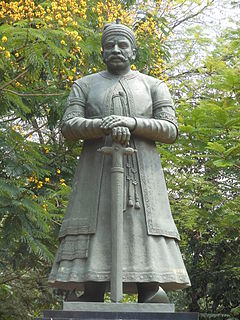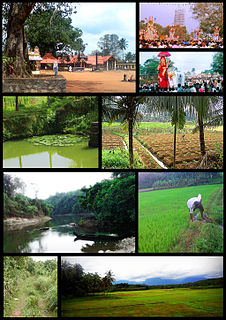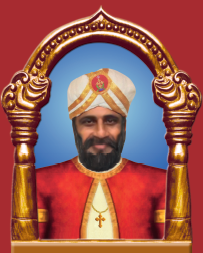
The Kingdom of Travancore (/ˈtrævənkɔːr/), also known as the Kingdom of Thiruvithamkoor, was an Indian kingdom from c. 1729 until 1949. It was ruled by the Travancore Royal Family from Padmanabhapuram, and later Thiruvananthapuram. At its zenith, the kingdom covered most of the south of modern-day Kerala, and the southernmost part of modern-day Tamil Nadu with the Thachudaya Kaimal's enclave of Irinjalakuda Koodalmanikyam temple in the neighbouring Kingdom of Cochin. However Tangasseri area of Kollam city and Anchuthengu near Attingal in Thiruvananthapuram district, were British colonies and were part of the Malabar District until 30 June 1927, and Tirunelveli district from 1 July 1927 onwards. Travancore merged with the erstwhile princely state of Cochin to form Travancore-Cochin in 1950. The five Tamil-majority Taluks of Vilavancode, Kalkulam, Thovalai, Agastheeswaram, and Sengottai were transferred from Travancore-Cochin to Madras State in 1956. The Malayalam-speaking regions of Travancore-Cochin merged with the Malabar District and the Kasaragod taluk of the South Canara district in Madras State to form the modern Malayalam-state of Kerala on 1 November 1956, according to the States Reorganisation Act, 1956 passed by the Government of India.

Pathanamthitta District, is one of the 14 districts in the Indian state of Kerala. The district headquarters is in the town of Pathanamthitta. There are four municipalities in Pathanamthitta: Adoor, Pandalam, Pathanamthitta and Thiruvalla.
'Paliath Achan or Paliyath Achan is the name given to the oldest male member of the Paliam family. The "Paliath Achans" took power in Chendamangalam as the descendants of Villarvattam Raja who retreated to Udayam Perur due to the fall of Kodungallur and the decline of his race.It is believed that "Paliyath Achans" were the accountants of the Cochin kings. It is assumed that they were the Buddhists who settled at Mahadevarpattanam (Chendamangalam), during the period of Aryanization. When Villarvattam was declined, it was probably a "Komi Achan" who was adopted into the royal family. There is no evidence to suggest that the Paliath family belonged to the upper caste community during the Portuguese rule. But they were given a position above the Nayars in the social structure. The fact that locals used to address the Buddhist monks by giving them the title of 'Achan' is memorable here. There is other evidence to prove that the Paliyam family had a connection with Buddhism. The 'Paliyam chepedu' of the 9th century was discovered by T. A. Gopinatha Rao, the head of the Travancore Archeology Department, in 1917. 'Chepedu' mentions the donation made by Vikramadityavaraguna to a Buddhist temple in Sreemoolavasam(Kodungallur). Kodungallur, north of Chenda-Mangalam, was at that time the seat of this famous Buddhist center. There is an idol of 'Tara' belonging to the Buddhist tradition in the Paliyam palace.

Chengannur is a Municipality in the Alappuzha district of Kerala State, India. It is located in the extreme eastern part of the Alappuzha district, on the banks of Pamba River.

Thalayolaparambu is a town situated in Kottayam district in Kerala, India. Spanning over an area of 19.3 square kilometres with a population of 22,571 people, this mini-town is home to some of the well-known personalities such as the former Chief minister of Travancore-Cochin A. J. John, Anaparambil, the late Malayalam novelist/writer Vaikom Muhammed Basheer, the former Chief Justice of India K. G. Balakrishnan, former President K. R. Narayanan and the Convenor of Left Democratic Front (LDF) in Kerala Vaikom Viswan, Jaykar T S, M.A.Mohammad, Vaikom Shamsudeen K V Pradeep Kumar, Principal Asramam H S S Vaikom. Thalayolaparambu also hosts the major market established during the administration of Velu Thampi Dalawa, and is one of those few Keralite markets that still retains its old-world charm till date.

Kilimanoor is a panchayat and a town in the Chirayinkeezhu taluk of Trivandrum district in Kerala, India. It is located on MC/SH 1 Road, 33 kilometres (21 mi) North-west of the city of Thiruvananthapuram (Trivandrum), 14 km east of Attingal and 20 km (12 mi) east of Varkala.

Velayudhan Chempakaraman Thampi ofThalakulam (1765–1809) was the Dalawa or Prime Minister of the Indian kingdom of Travancore between 1802 and 1809 during the reign of Bala Rama Varma Kulasekhara Perumal. He is best known for being one of the earliest individuals to rebel against the British East India Company's authority in India.

Pattazhy, also Pattazhiis a village located in Pathanapuram taluk in the eastern part of the Kollam District, Kerala state, India. It is best known as the site of an ancient Bhagavathy temple, Pattazhy Devi Temple.

Thachil Mar Matthoo Tharakan (1741–1814) was a Saint Thomas Christian merchant, social leader and minister who played a key role in Kerala, especially in its Travancore and Cochin regions, in India towards the latter part of the 18th century and early 19th century. He relentlessly worked to bring about a reunification in his community which was divided into Catholic (Pazhayakūr) and Jacobite (Puthenkūr) after the Coonan Cross Oath of 1653. He organized his community against the colonialist attempts of Portuguese and played a prominent role in the assembly of Catholic Saint Thomas Christians at Angamāly that paved the way for the establishment of independent Syro-Malabar hierarchy.

Maharani Ayilyom Thirunal Gouri Lakshmi Bayi (1791–1815) was the Maharani of the Indian state of Travancore from 1810 till 1813 and Regent from 1813 till her death in 1815 for her son Swathi Thirunal Rama Varma. She was the only Queen of Travancore to have reigned in her own right which she did for two years before becoming a regent.

Kundara is a census town in Kerala and is part of the Kollam Metropolitan Area, India. Kundara is situated 13 km east of Kollam city, 14 km west of Kottarakkara, and 24 km north of Paravur. Kundara is significant for its historic involvement in the Indian independence movement.

Enathu is a village in Adoor Thaluk of Pathanamthitta district in the state of Kerala, India.

Kadampanad grama panchayath is the southernmost part of Pathanamthitta district. It comes under Parakkode block of Adoor taluk. The panchayath shared boundaries with Erathu panchayath in the north, Ezhamkulam panchayath in the east, Kunnathur panchayath and Kalladayar in the south and Pallikkal and Poruvazhy Panchayaths in the west. Kakkathikkunnu in the north and Pandimalakkunnu (Pandimalappuram) in the south stands as two strong forts in this panchayath which balances the climatic conditions of this area.
Kannammoola is an urban neighborhood of Thiruvananthapuram, Kerala, India. The Aakkulam lake that forms a part of the Kerala backwaters is situated in Kannammoola.

Vaikom Padmanabha Pillai (1767–1809) was a militia leader and military officer of the Kingdom of Travancore. In 1808 he led an uprising against British control in Travancore. He was captured in 1809 and hanged for his role in the rebellion.
The Travancore rebellion against the British East India Company was led by the prime ministers of the Indian states of Travancore and Cochin in 1808–09 with support from Sikhs ruling Punjab.

Veluthampi Dalawa is a 1962 Malayalam-language historical drama film based on the life of Velu Thampi Dalawa, the Dewan of Travancore during the first decade of 19th century, was one of the first to rebel against the British East India Company's supremacy. The film, directed by G. Viswanath and written by Jagathy N. K. Achary was shot in Newton Studios. Kottarakkara Sreedharan Nair, Thikkurissy Sukumaran Nair, Prem Nawas, Adoor Bhasi, G. K. Pillai, Ragini, Ambika Sukumaran and Sukumari portrayed prominent roles. The dances were choreographed by Chinni and Sampath along with Kalamandalam Madhavan. The film was a box office success.
Mundankavu is a village situated 2 kilometres (1.2 mi) from Chengannur in Alappuzha district, Kerala, India. It lies on the banks of the river Pampa. It is known as Vadakekkara which is situated on the northern banks of River Pampa
The Battle of Quilon was fought on the 15 January 1809 at Cantonment Maidan in Quilon, an important port city and business hub on the southwest coast of India. The conflict involved troops of the Indian kingdom of Travancore, led by the then Dewan of Travancore, Velu Thampi Dalawa, and a detachment of the British East India Company under Colonel Chalmers. The battle lasted for only six hours and is closely associated with the social and political history of Kerala.
This is the History of Pathanamthitta district. Pathanamthitta district is located in the southern region of Kerala, a state in South India.
















